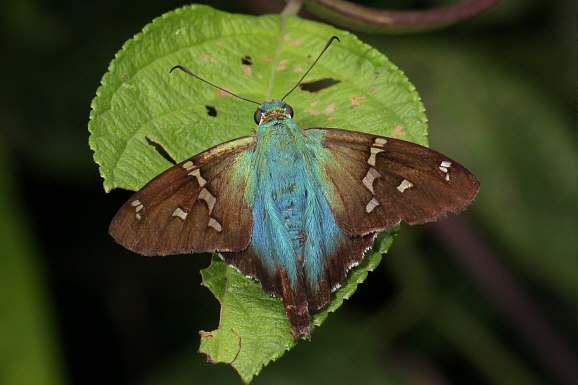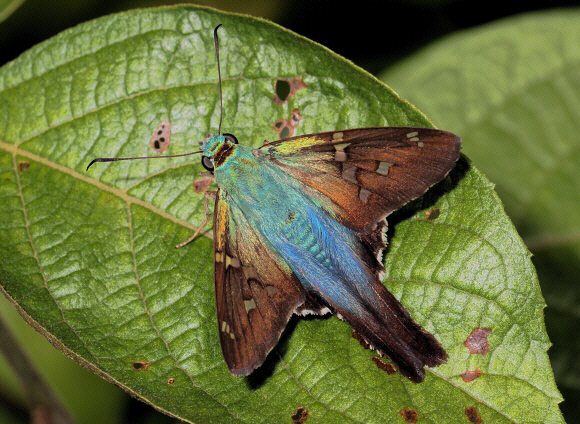
Introduction
The Pyrginae, popularly known as Flats or Spreadwings, are a cosmopolitan subfamily distributed across temperate and tropical habitats throughout the world. In the Americas there are 990 species.
The Eudamini includes 44 genera in the Americas. There are several genera of Long-tailed Skippers Urbanus, Chioides, Polythrix, Typhedanus and Aguna; which together comprise of about 95 species.
The forewings of long-tailed Skippers usually have either a thin white median band, or a pattern of diaphanous spots, the configuration of which varies according to genus and species. A feature that helps narrow down the genus is the pattern on the underside hindwings. In Aguna for example these are marked with a prominent white median band, while Chioides and Typhedanus are marbled with blackish markings. Urbanus species typically have a fairly plain underside marked with parallel dark bands, although in several species the inner band is broken up into a series of 3 or 4 large blotches.
There are 34 Urbanus species, distributed variously from Texas to Paraguay and Argentina.
Urbanus belli is a widespread but uncommon species, found from Mexico to Argentina.

Habitats
This butterfly is associated with disturbed habitats including forest glades, tracks and clearings, at altitudes between about 200-1000m.
Lifecycle
The eggs of Urbanus species are typically cream or greenish in colour, barrel-shaped and have about 15 vertical ridges. They are laid in small clusters on the undersurface of leaves.
The foodplants of belli are unrecorded but probably include several herbaceous members of the family Leguminosae. The larvae of other Urbanus species live solitarily within a shelter constructed by rolling up a leaf of the foodplant and lining the inside with silk.
Adult behaviour
The butterflies are usually seen singly, basking with wings half-open on low foliage. In overcast weather or at dawn they will sometimes bask with wings fully outspread, but like most Urbanus species they are acutely aware of what is going on around them, and are nervous and energetic, taking flight immediately if disturbed. Even if frequently disturbed however the males will repeatedly return to the same perch, or one of several regularly used perches in the immediate vicinity. They have a very rapid whirring flight, dashing back and forth, and often circling unnoticed around an observer and settling behind him or her.
Males feed at bird droppings, and sometimes imbibe mineralised moisture from damp roadsides and riverbanks.

